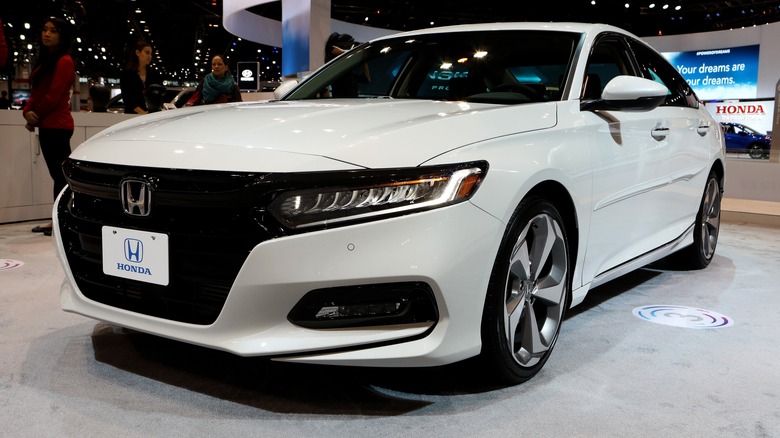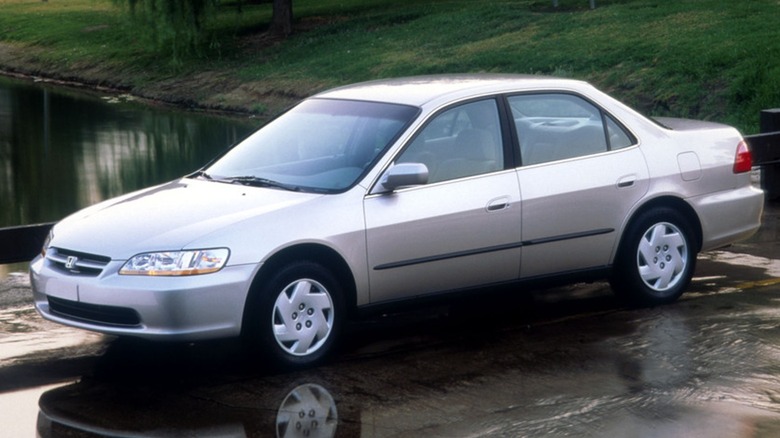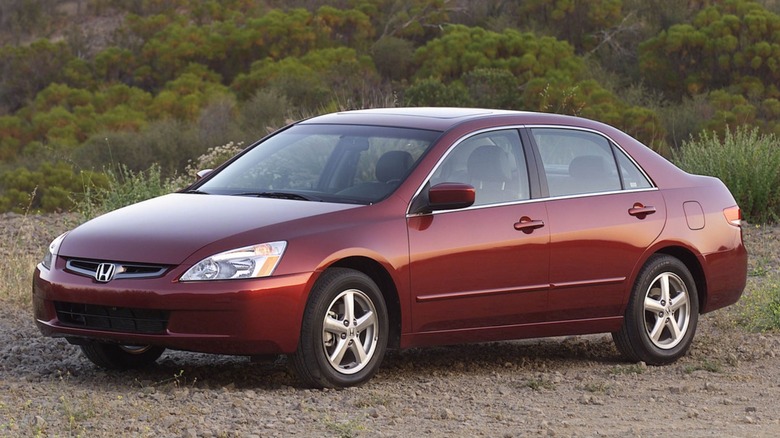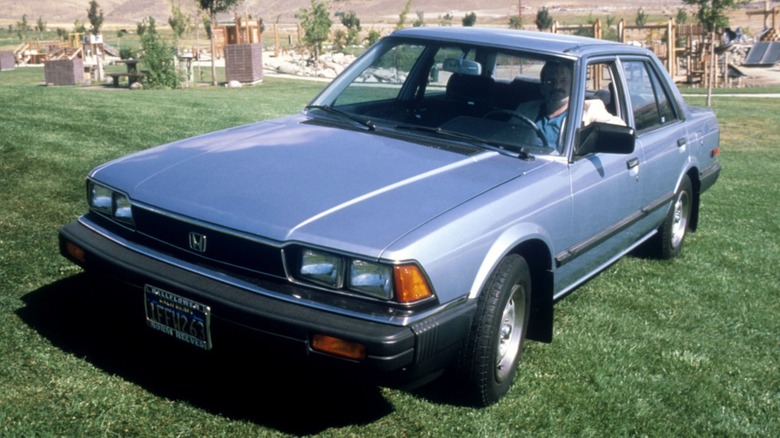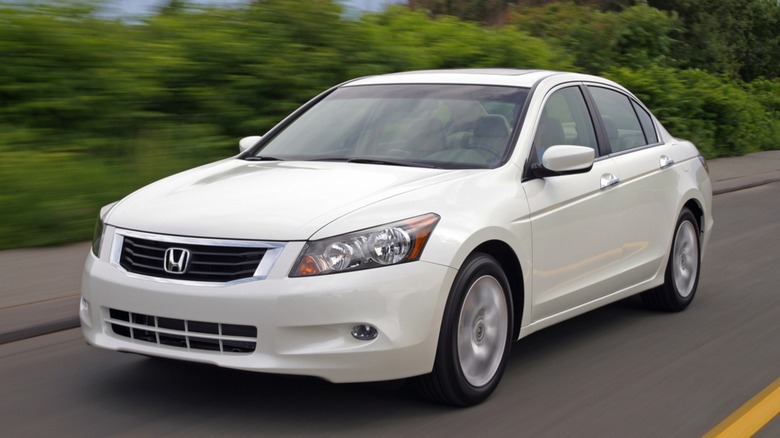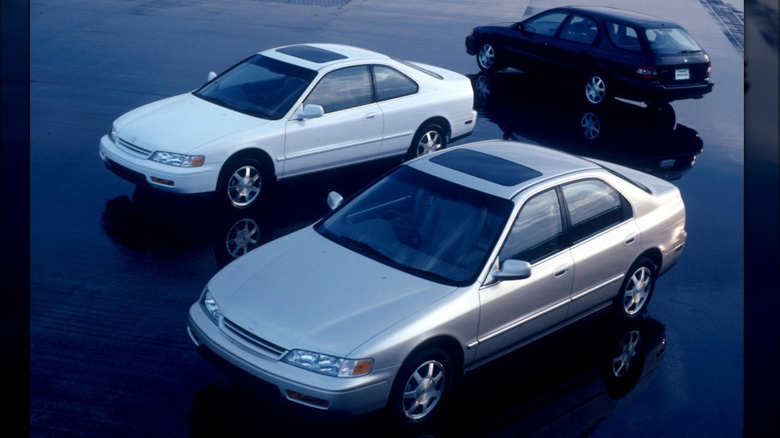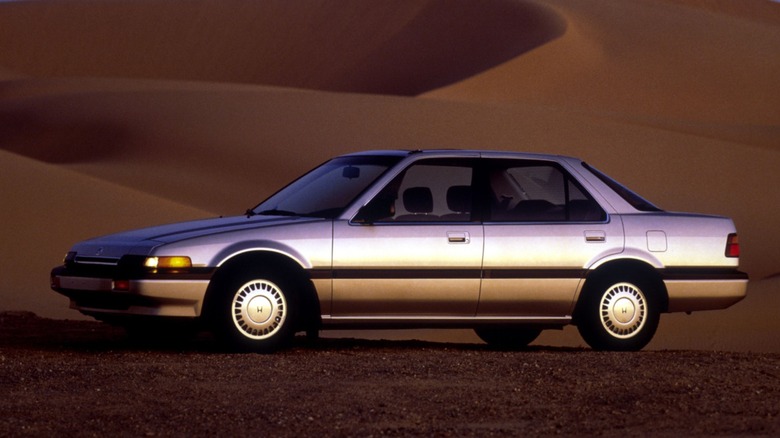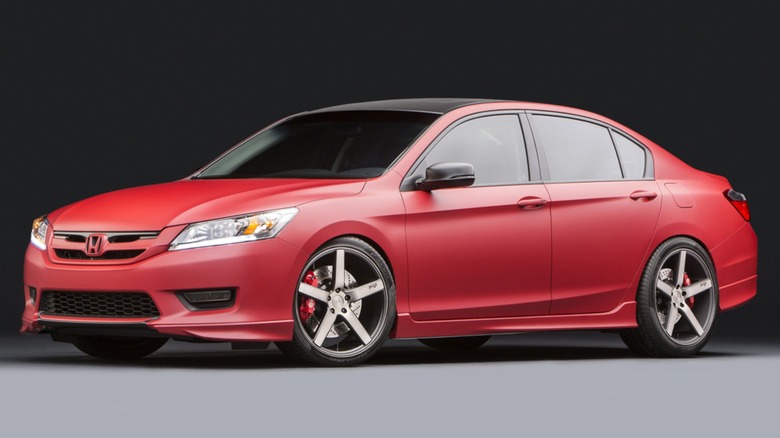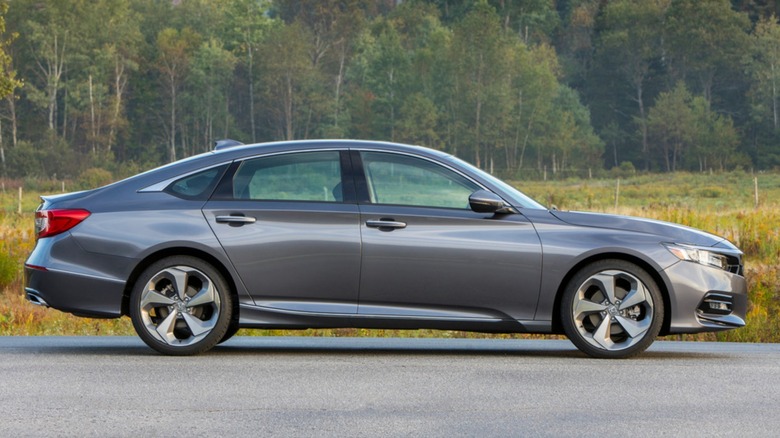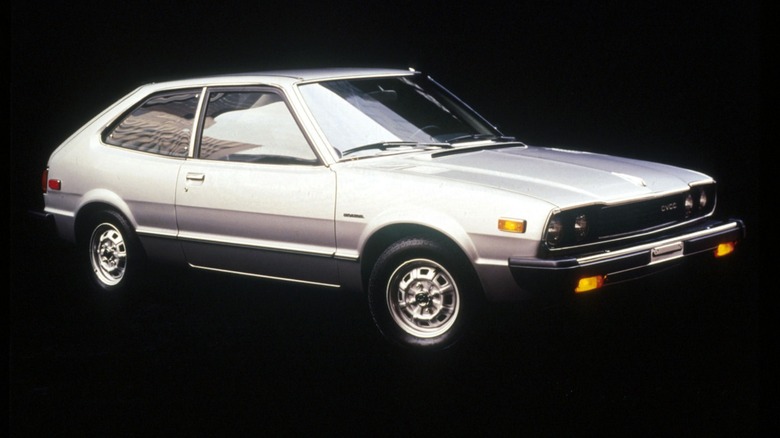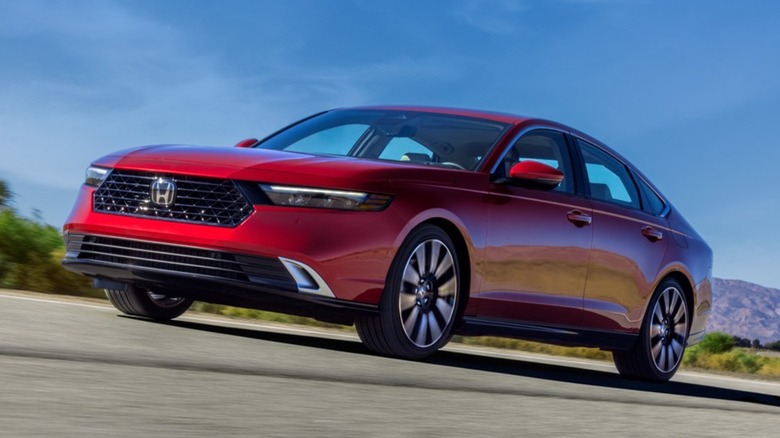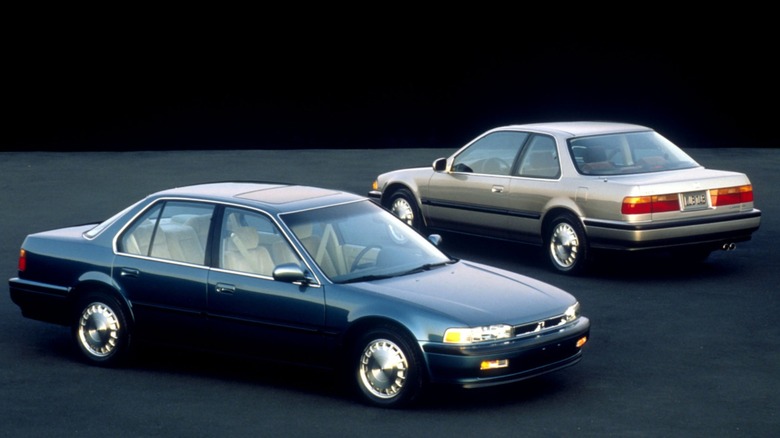Every Generation Of Honda Accord Ranked, Worst To Best
When Honda first introduced its larger alternative to the compact Honda Civic, few in the American market would have predicted it would be a powerhouse of the American passenger car market and a darling of the automotive press. To be fair, the early Accord was a very basic car that was dwarfed by even intermediate-sized American sedans. American automakers had broadly downsized their cars for 1976, yet the first-year model at 162.8 inches was still dwarfed by the downsized Chrysler Cordoba's 215-inch length. Honda had plenty of work to do in 1976 if it wanted to be dominant in the American market, the biggest in the world at that time.
Honda worked hard to gain market share, relying on superior build quality and innovative engineering solutions to sell its products. The formula worked as sales grew each year so much that in 1982, Honda opened its own American manufacturing facility in Marysville, Ohio. The first automobile to leave that plant was an Accord, and manufacturing of the model continues there today. By 1989, the Accord became the best-selling passenger car in the United States and decades on it is still a favorite among American drivers, even as SUV sales make up an increasing portion of new car sales.
As the Accord approaches its 50th anniversary, this is every generation listed in order from worst to best.
11. Honda Accord Sixth Generation (1998-2002)
The sixth generation model ran from 1998 to 2002 and featured styling that largely updated the outgoing model with less radical changes than in previous generations. Overall, these cars are attractive but perhaps a bit plain. Inside you will find well-appointed interiors with clean lines and a generally uncluttered appearance, hallmarks of Honda interior design of the era. Aesthetically, there is not much to complain about with this generation, although there also may not be much to get excited about either.
While a 1998 or 2000 Accord looks like a perfectly fine car to own from outward appearances, something untoward lurks beneath the surface. Around the time of the new millennium, Honda's legendary reputation for reliability did a bit of backsliding, which affected Accords from this period. Most notable with the 6th generation were transmission problems, among the most beguiling of all automotive breakdowns. Many cars from this era suffered from serious transmission failures as a result of manufacturing defects causing heat build-up. The problem became so serious and widespread that they were reported on by The New York Times.
Subsequently, Honda offered extended warranties for the transmissions, raising the mileage limit to 100,000 miles –- most failures occurred before 90,000.
10. Honda Accord Seventh Generation (2003-2007)
Honda managed to straighten out most of its transmission problems shortly after it released the 2003 Accord, but someone seems to have forgotten to bother with how it looked. Out of all the generations of Accord, this one is perhaps the most bland and least inspired, aesthetically speaking. Some people don't care about a car so long as it is reliable and comfortable, which might make this the perfect car for them. However, most of us care about style and will likely pass on this for something a bit more sporting.
Honda made a lot of changes to its Accord for 2003. Many of them were mechanical, with the first application of Honda's variable valve system, i-VTEC, making its first appearance in 2003 for this model. The 4-cylinder options received 10 horsepower boosts but gave the V6 a shot in the arm with an extra 40 ponies under the hood by reworking the engine with some engineering tricks thanks to Honda's excellent research and development. Furthermore, the suspension received fairly extensive upgrades to make this an even better handling version of an already great handling car.
However, model year 2001 to 2003 cars are affected by the Takata airbag recall, so it is imperative to ensure they have been repaired before driving them. Still, this is not a reason to avoid a seventh-generation Accord. By all accounts, it is a good car. It is just a bit dull on the outside, which brings it down overall.
9. Honda Accord Second Generation (1982-1985)
With the inroads made by the first generation of Accord, Honda was ready to keep the model going and updated it for the 1982 model year. This one seems to be a case of not wanting to change the formula that had worked too much, lest you mess things up.
In that vein, most of the car wasn't changed all too much, aesthetically speaking. The dashboard was brought along for the new model mostly unchanged, although it did receive an updated steering wheel. Otherwise, the interior remained basic and in line with what the car was meant to be at the time — an affordable import. The exterior styling did receive some updates to modernize the look and the headlights switched from round to square. All in all, it was still an Accord, and that is a good thing, even back then.
For Honda, then and now, incremental changes have always been a part of the formula. Bringing out a good product and working a bit each year to perfect has been the story of the Accord. The second generation just needed to be a bit better than the one before and Honda could continue to build its repeat customer base until major changes could be made without alienating the base of support. Therefore, this generation of Accord is fine, and that is all it ever needed to be.
8. Honda Accord Eighth Generation (2008-2012)
After a bit of a decline in the early 2000s, Honda sought to bring its flagship sedan back up to the quality consumers were accustomed to. The redesigned 2008 model debuted with new styling that took a conservative approach while improving the overall aesthetic. Mildly flowing curves accentuated by strategically placed creases and folds on its sheet metal made this generation Accord an attractive sedan that represented the look of a safe choice for buyers.
Interiors had become a premium affair by this time, and Honda offered a range of options to make its Accord rival luxury cars for the array of conveniences and power functions available. Color screens with navigation were now a standard part of the automotive world, although their functionality pales in comparison to modern versions. Engine options included a 2.4-liter inline-4 or a 3.5-liter V6. The 4-cylinder featured dual-overhead cams with i-VTEC and multi-port fuel injection, making it good for 177 horsepower while the V6 delivered 190.
This generation Accord can suffer from a few problems. It seems that the more technology that is placed into cars, the more they are susceptible to failure. While there are a few trouble spots, overall this Accord is as good as any car gets from this era. Furthermore, with an NHTSA safety rating of five out of five in all categories but one — where it still received four out of five — this Accord was always a safe bet. It is not a terribly exciting car overall, but it was never intended to be. That is plenty for most Accord buyers.
7. Honda Accord Fifth Generation (1994-1997)
Honda's vehicles of the '90s were uniformly excellent with exceptional build quality and endless reliability. The Accord had come into the '90s on a high mark, so a redesigned model needed to stretch high to hit the bar set for it. Fortunately, Honda was up to the task and released another reliable sedan.
The previous car's styling was rather conservative, so Honda wanted to update it to attract younger customers but not so much as to turn away older ones. The resulting car struck a balance. It used flowing lines with plenty of curves to show it was a modern design but had also benefited from extensive wind tunnel testing. Much of the excellent existing suspension was held over but improved for a softer ride while retaining good handling, making it even more comfortable for long highway drives. VTEC variable valve timing arrived for the first time as well as a V6 engine in an Accord.
Another unseen advantage of this generation is that it was built for far less money than its predecessor, which went way over budget and cost Honda much in profits. The fifth-generation Accord helped Honda to bring back profits, which it did by becoming a best-selling car again. Taurus had edged it out by 1993 and Accord surpassed it again in 1997, although they both trailed behind Camry at that point.
6. Honda Accord Third Generation (1986-1989)
By the mid-'80s, the Accord was a solid hit and fast becoming one of America's favorite passenger cars. Since Honda had its foot well past the threshold of the door, it could now focus on making cars that went above and beyond to take on the Detroit giants. It started doing this most competently with the 1986 Accord, which was built in Ohio.
A thorough redesign introduced what was then a very modern sedan in terms of style. The new design was wedge-shaped with the leading edge kept low to the ground thanks to pop-up headlights, which gave it a sleek sports car look up front with sensible passenger space trailing behind. Likewise, the interior raised the bar significantly from earlier versions of this car, with premium feeling material that felt solid and tight. Many domestic cars of this era are known for having flimsy interiors that creak and rattle –- none of that was found on the Accord. Engines still received fuel by carburetor but a fuel-injected version was offered with top trim levels.
By far the defining feature of this car was the excellent handling care of a suspension adapted from sports cars, making this fun to drive and planted on the road. This Accord proved Honda was ready for the big time, and excellent sales provided confirmation.
5. Honda Accord Ninth Generation (2013-2017)
2013 was the first year the Accord received a dynamic 8-inch color screen across all trim levels. This change heralded a slew of technology updates throughout the car, notably those under the hood. This generation was the first to receive direct injection across the range, and the V6 option also received i-VTEC as the smaller engines had with previous models. Both of these changes led to more power with better efficiency. A 4-cylinder Accord at this time could achieve up to 36 mpg and those who went with the V6 were blessed with an impressive 278 horsepower. Even with this boost in power, fuel efficiency only dropped to 30 mpg.
That 8-inch color screen displayed a range of information for drivers, but only the higher trim levels received navigation. Regardless, the system performed well for the time, offering Bluetooth for streaming music and HondaLink for other internet-connected communications. Transmission options were 6-speed manual or automatic, and for the first time, a CVT.
Styling of the ninth generation Accord was initially an evolution of the eighth generation, although it went through a mid-cycle refresh that gave it a more aggressive appearance, foreshadowing the more stylized look of future Accords. This generation of Accord represents a continuation of the previous generation, not showing many radical changes but building upon a formula that had been working for several years. It was a fine car, which is what Honda customers had come to expect.
4. Honda Accord Tenth Generation (2018-2022)
Heading into the 2020s, Honda chose to make some significant changes to its Accord inside, outside, and underneath. Exterior design, elements of which had appeared a couple of years earlier, became much more aggressive and modern, perhaps in a way as to draw in younger buyers. Accords had been conservative for many years, and automotive styling had become more daring across the board.
As such, 2018 became a year of many updates for the Accord line. A touchscreen debuted this year as well as turbocharging for the first time in an Accord. The 2.4-liter 4-cylinder was gone and so was the V6. In their place, customers chose from either a turbocharged 1.5-liter or 2.0-liter 4-cylinder. Even though engine size was reduced, power was still on offer with either 192 horsepower or 252 horsepower on tap.
With a long list of options, an exceptionally nice interior, and the continued Honda reliability, it is hard to find many faults with this car. The styling is attractive and the driving experience was as good as ever for an Accord, making this a solid pick for those who want a good car that stands out amidst a sea of SUVs.
3. Honda Accord First Generation (1976-1981)
The automotive landscape changed drastically in the early '70s, which proved to be a perfect time for Honda to begin exporting their tiny and efficient cars to the United States. This meant that by 1976 the company had been selling the Civic for several years and had no trouble introducing what would one day become the best-selling car in America — at least, for a while.
The first Honda Accord arrived as either a sedan or hatchback. With its proven CVCC engine, which was designed so well it did not require a catalytic converter, the larger Honda offered a whopping 68 horsepower of imported fury. No, it was not fast nor was it big, but it was well-built and dependable. It may not have been the flashiest or sleekest automobile around -– styling was simply not the point of an early Accord. What the Accord needed to be for its owner was reliable, efficient, and comfortable. These cars were quite acceptable for everyday driving, and they did for Honda what they needed to by establishing the company as a serious competitor.
The first-generation Accord gets rated highly not necessarily for being the best car ever. It was adequate. It is rated highly for being the beginning of a long line of better-than-adequate cars loved by millions. Today, a well-preserved copy of an early Accord is truly a gem to be cherished.
2. Honda Accord Eleventh Generation (2023-present)
Viewing the current Honda Accord, it is hard to imagine what this model started as in 1976. No longer is it a small, slow, and basic little car, but the high build quality and dependability remain. The base model even has the same size engine as the original, albeit with more than double the power.
One of the things this new Accord does is keep it classy, so to speak. Much of the direction of new cars is to make them sleek and modern but also garish and overwrought. Honda managed to avoid this by only going for the sleek and modern. It has done so by making the Accord look great and feel great as if it is a luxury car priced much lower than what it actually offers. All modern cars come packed with an impressive array of technology. However, this often leads to a dizzying array of functions that can overwhelm drivers. The Accord manages to keep things more simple while still providing everything you may want, plus just a little extra.
All of this translates to how it works on the road. Handling is sure-footed without being too harsh and apes the favorite luxury sports sedans of a previous era. Furthermore, if you choose the hybrid model, you will get up to 46 mpg with hardly any sacrifice in power, the best of both worlds. In just a few short years, the Accord will celebrate 50 years of production, and this car is a testament to its longevity and continued popularity. It is still an excellent choice all around.
1. Honda Accord Fourth Generation (1990-1993)
When Honda introduced its new Accord model in 1989, potential buyers previewed what looked like an all-new car. Gone were the pop-up headlights and the angular wedge shape, replaced by softer corners, integrated headlights, and an overall extremely attractive package. The Accord had become the best-selling car in America, so Honda had a lot to live up to with the next iteration to retain its title. Fortunately, it did just that.
Significant upgrades went into the new car. The engine displacement was brought up to 2.2 liters and the valves-per-cylinder doubled from two to four. Furthermore, all Accords were now fuel-injected with Honda's remarkable PGM-Fi electronic injection system. The car was also stretched by seven inches and practically everything had been reworked from scratch. This generation was the first designed and built specifically with the American market in mind, and it was the last Honda effort that was led by engineering. As a result, they ended up with an impeccably built car that was attractive and enjoyable to drive — even if it cost too much to make.
Driving a fourth-generation Accord reveals a car that feels rock solid and fun to drive. The interior is ergonomic and comfortable, and the quality can be felt throughout. There are few, if any, common problems with these cars, many of which went 100,000 miles without any repairs. While the styling is conservative, it is still an attractive car. While new Accords are more sophisticated, larger, and faster, this generation may still be the best Honda ever made.
